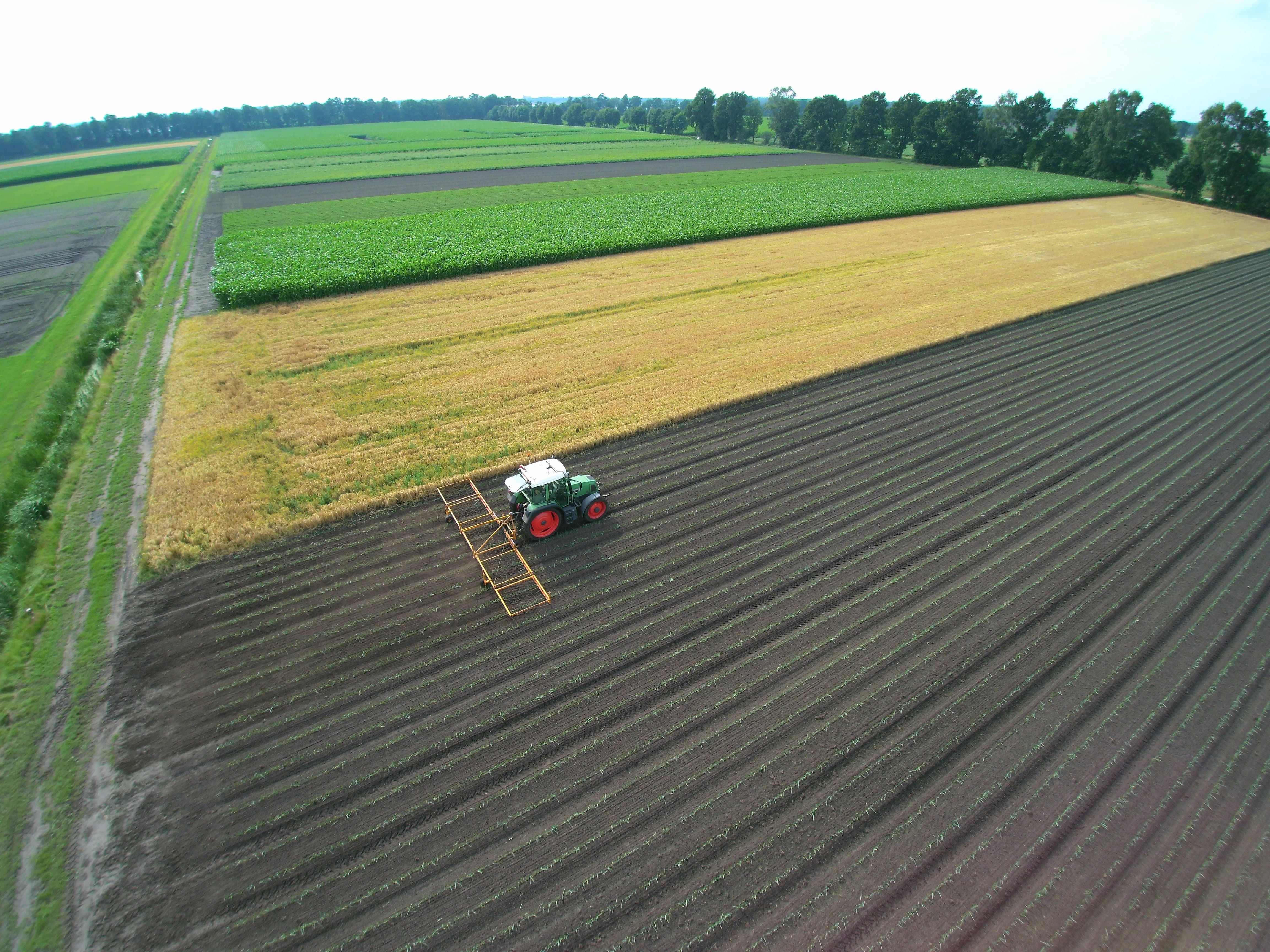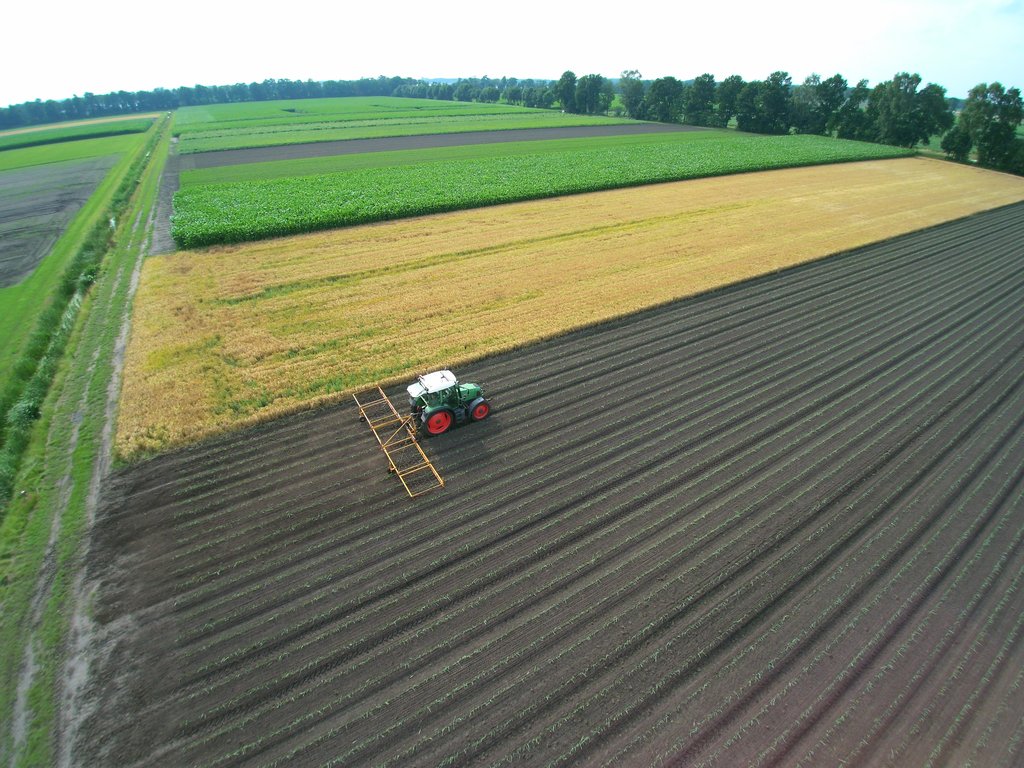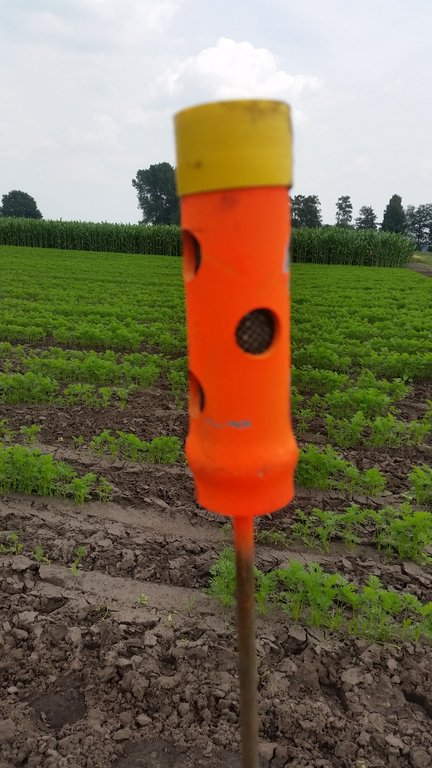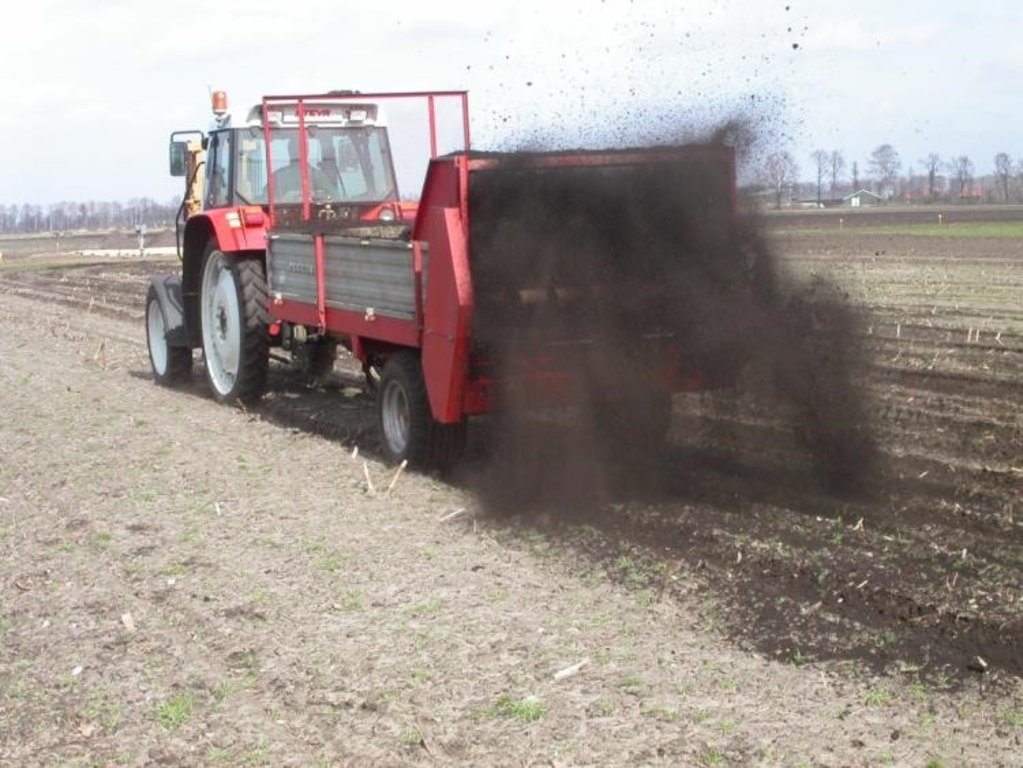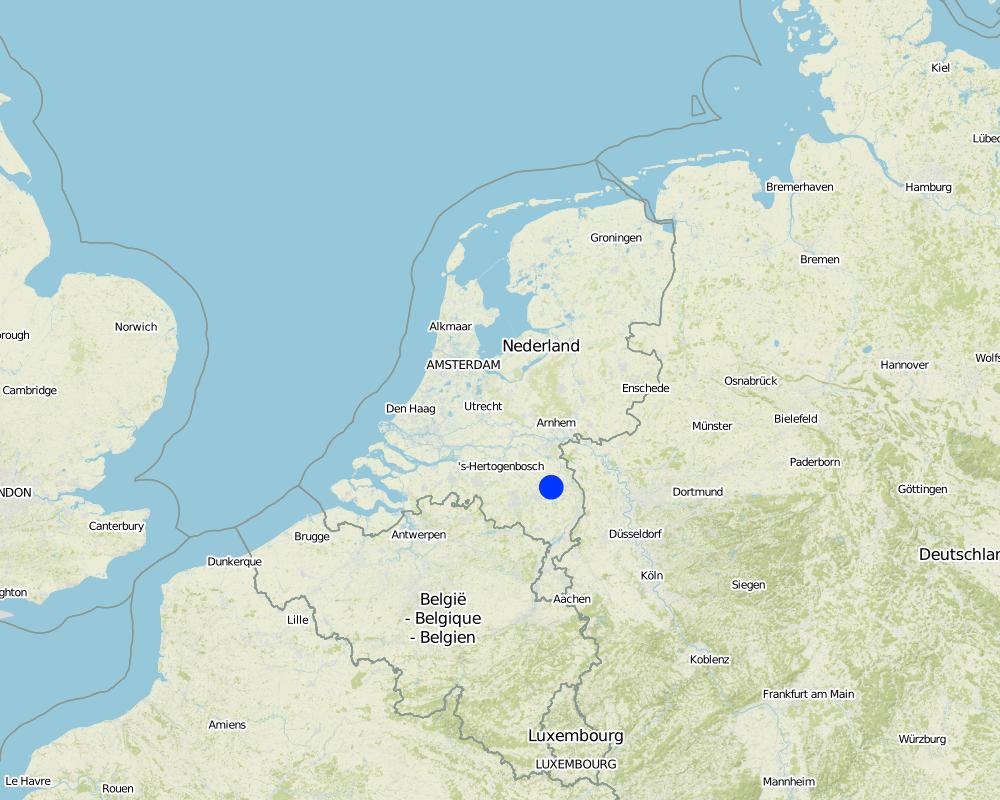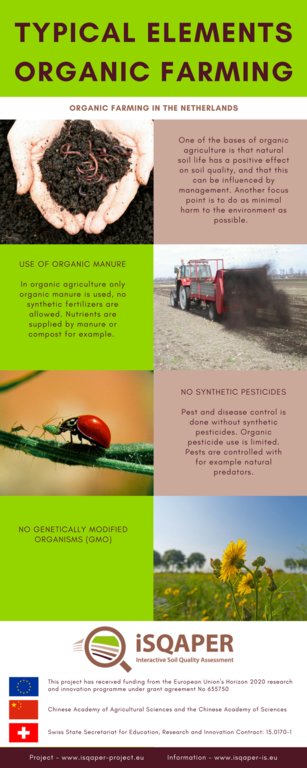Organic agriculture with vegetable and arable crops on sandy soils [Netherlands]
- Creation:
- Update:
- Compiler: wijnand sukkel
- Editor: Marie Wesselink
- Reviewers: Ursula Gaemperli, Gudrun Schwilch
biologische landbouw met groente en akkerbouw gewassen op zandgronden
technologies_2978 - Netherlands
View sections
Expand all Collapse all1. General information
1.2 Contact details of resource persons and institutions involved in the assessment and documentation of the Technology
Name of project which facilitated the documentation/ evaluation of the Technology (if relevant)
Interactive Soil Quality assessment in Europe and China for Agricultural productivity and Environmental Resilience (EU-iSQAPER)Name of the institution(s) which facilitated the documentation/ evaluation of the Technology (if relevant)
Stichting Dienst Landbouwkundig Onderzoek, Wageningen University & Research Centre (DLO) - Netherlands1.3 Conditions regarding the use of data documented through WOCAT
When were the data compiled (in the field)?
20/07/2017
The compiler and key resource person(s) accept the conditions regarding the use of data documented through WOCAT:
Ja
1.4 Declaration on sustainability of the described Technology
Is the Technology described here problematic with regard to land degradation, so that it cannot be declared a sustainable land management technology?
Nee
2. Description of the SLM Technology
2.1 Short description of the Technology
Definition of the Technology:
Certified Organic Agriculture (EU standards) with a combination of arable and vegetable crops on sandy soils in the Netherlands
2.2 Detailed description of the Technology
Description:
The technology is applied in a vegetable/arable production system on sandy soils in the Netherlands, but could be applied in various production systems on various soils. There are not directly environmental constraints for the application of certified organic agriculture.
Main characteristics of certified organic production can be found in the standards for organic production in the EU (Council Regulation (EC) No 834/2007). Purpose of the technology is sustainable production in a broad sense. Concerning soil management, focus is on maintaining soil quality and preserving (soil) biodiversity. Major inputs are organic fertilizers. No synthetic fertilizers and no synthetic pesticides are used. In practice in the de Peel region where this technology is applied also the use of 'organic' pesticides is minimal.
The impacts of the technology are:
- a better soil quality in general,
- reduced nitrate emissions to groundwater,
- better water holding capacity,
- and more stable yield which are however on average 20% lower than conventional yield.
Yield reduction is mainly due to pests and diseases. The economic performance of the system is good (better than conventional production).
Land user like this technology because of the good economic result and because it call upon their craftmanship as a farmer. Then again, farmers dislike it because its complicated, and pests are sometimes hard to control and finally because of additional handlabour needed for weed control.
2.3 Photos of the Technology
2.5 Country/ region/ locations where the Technology has been applied and which are covered by this assessment
Country:
Netherlands
Region/ State/ Province:
De Peel
Further specification of location:
located close to the village Vredepeel
Map
×2.6 Date of implementation
Indicate year of implementation:
1998
2.7 Introduction of the Technology
Specify how the Technology was introduced:
- through land users' innovation
- during experiments/ research
- through projects/ external interventions
Comments (type of project, etc.):
The rising awareness of the importance of sustainable production and landuse makes that organic farming more and more applied, in research/projects as well as by the farmers themselves.
3. Classification of the SLM Technology
3.1 Main purpose(s) of the Technology
- reduce, prevent, restore land degradation
- preserve/ improve biodiversity
- adapt to climate change/ extremes and its impacts
- create beneficial economic impact
3.2 Current land use type(s) where the Technology is applied

Cropland
- Annual cropping
Main crops (cash and food crops):
1:6 rotation: potato, pea, leek, summer barley, sugarbeet, maize
3.3 Further information about land use
Water supply for the land on which the Technology is applied:
- mixed rainfed-irrigated
Number of growing seasons per year:
- 1
3.4 SLM group to which the Technology belongs
- rotational systems (crop rotation, fallows, shifting cultivation)
- integrated soil fertility management
- integrated pest and disease management (incl. organic agriculture)
3.5 Spread of the Technology
Specify the spread of the Technology:
- evenly spread over an area
If the Technology is evenly spread over an area, indicate approximate area covered:
- 0.1-1 km2
3.6 SLM measures comprising the Technology

agronomic measures
- A1: Vegetation/ soil cover
- A2: Organic matter/ soil fertility
- A5: Seed management, improved varieties

management measures
- M2: Change of management/ intensity level
3.7 Main types of land degradation addressed by the Technology

soil erosion by wind
- Et: loss of topsoil

chemical soil deterioration
- Cn: fertility decline and reduced organic matter content (not caused by erosion)

physical soil deterioration
- Pc: compaction

biological degradation
- Bs: quality and species composition/ diversity decline
- Bl: loss of soil life

water degradation
- Hq: decline of groundwater quality
3.8 Prevention, reduction, or restoration of land degradation
Specify the goal of the Technology with regard to land degradation:
- prevent land degradation
4. Technical specifications, implementation activities, inputs, and costs
4.1 Technical drawing of the Technology
4.2 Technical specifications/ explanations of technical drawing
The most important aspects of organic agriculture are: application of only organic manure and no application of synthetic pesticides, with the idea that soil quality and environment can be positively effected by this.
4.3 General information regarding the calculation of inputs and costs
Specify how costs and inputs were calculated:
- per Technology area
Indicate size and area unit:
50 hectares
other/ national currency (specify):
euro
Indicate exchange rate from USD to local currency (if relevant): 1 USD =:
0.87
Indicate average wage cost of hired labour per day:
160
4.4 Establishment activities
| Activity | Type of measure | Timing | |
|---|---|---|---|
| 1. | Change machinery (mainly for weed control) | Management | before during conversion period |
| 2. | stop using synthetic pesticides and nutrient | Management | beforer conversion period |
| 3. | choose conversion period crops | Agronomic | 2 years before start certified organic production |
| 4. | start conversion period (2 years) | Management | 2 years before start certified organic production |
| 5. | design and adapt crop choice and rotation | Agronomic | before and during conversion period |
4.5 Costs and inputs needed for establishment
| Specify input | Unit | Quantity | Costs per Unit | Total costs per input | % of costs borne by land users | |
|---|---|---|---|---|---|---|
| Equipment | investments in mechanical weed control machinery | piece | 1.0 | 50000.0 | 50000.0 | 100.0 |
| Total costs for establishment of the Technology | 50000.0 | |||||
Comments:
Establishement costs are hard to estimate because it depends on the farm specific situation. However there will be a need to adapt the machinery for weed control and also there will be costs (or actually losses in turnover and profitability) in the conversion period because crops grown in the conversion period cannot yet be sold as organic against a premium price.
4.6 Maintenance/ recurrent activities
| Activity | Type of measure | Timing/ frequency | |
|---|---|---|---|
| 1. | mechanical weed control instead of herbicides | Agronomic | each cropping season |
| 2. | Handlabour for weed control | Agronomic | each cropping season |
| 3. | Spread of organic fertilisers instead of synthetic nutrients | Agronomic | each cropping season |
Comments:
There are a lot of small items that change after adopting organic agriculture. I just mentioned the most relevant ones
4.7 Costs and inputs needed for maintenance/ recurrent activities (per year)
| Specify input | Unit | Quantity | Costs per Unit | Total costs per input | % of costs borne by land users | |
|---|---|---|---|---|---|---|
| Labour | Additional handlabour mostly for weeding | hours | 250.0 | 160.0 | 40000.0 | 100.0 |
| Labour | Additional labour for mechanical weed control | hours | 75.0 | 160.0 | 12000.0 | 100.0 |
| Equipment | yearly costs of weed control mechanisation | euro | 1.0 | 5000.0 | 5000.0 | 100.0 |
| Total costs for maintenance of the Technology | 57000.0 | |||||
Comments:
The additional costs (compared to conventional) and yield losses are most of the time more than covered by additional income because of premium product prices. Costs are calculated for a 50 ha farm.
4.8 Most important factors affecting the costs
Describe the most determinate factors affecting the costs:
handlabour for weed control
5. Natural and human environment
5.1 Climate
Annual rainfall
- < 250 mm
- 251-500 mm
- 501-750 mm
- 751-1,000 mm
- 1,001-1,500 mm
- 1,501-2,000 mm
- 2,001-3,000 mm
- 3,001-4,000 mm
- > 4,000 mm
Specify average annual rainfall (if known), in mm:
850.00
Indicate the name of the reference meteorological station considered:
Volkel the Netherlands
Agro-climatic zone
- sub-humid
5.2 Topography
Slopes on average:
- flat (0-2%)
- gentle (3-5%)
- moderate (6-10%)
- rolling (11-15%)
- hilly (16-30%)
- steep (31-60%)
- very steep (>60%)
Landforms:
- plateau/plains
- ridges
- mountain slopes
- hill slopes
- footslopes
- valley floors
Altitudinal zone:
- 0-100 m a.s.l.
- 101-500 m a.s.l.
- 501-1,000 m a.s.l.
- 1,001-1,500 m a.s.l.
- 1,501-2,000 m a.s.l.
- 2,001-2,500 m a.s.l.
- 2,501-3,000 m a.s.l.
- 3,001-4,000 m a.s.l.
- > 4,000 m a.s.l.
Indicate if the Technology is specifically applied in:
- not relevant
5.3 Soils
Soil depth on average:
- very shallow (0-20 cm)
- shallow (21-50 cm)
- moderately deep (51-80 cm)
- deep (81-120 cm)
- very deep (> 120 cm)
Soil texture (topsoil):
- coarse/ light (sandy)
Soil texture (> 20 cm below surface):
- coarse/ light (sandy)
Topsoil organic matter:
- high (>3%)
5.4 Water availability and quality
Ground water table:
< 5 m
Availability of surface water:
good
Water quality (untreated):
for agricultural use only (irrigation)
Is water salinity a problem?
Nee
Is flooding of the area occurring?
Nee
5.5 Biodiversity
Species diversity:
- medium
Habitat diversity:
- medium
5.6 Characteristics of land users applying the Technology
Sedentary or nomadic:
- Sedentary
Market orientation of production system:
- commercial/ market
Off-farm income:
- less than 10% of all income
Relative level of wealth:
- rich
Individuals or groups:
- individual/ household
Level of mechanization:
- mechanized/ motorized
Gender:
- men
Age of land users:
- middle-aged
5.7 Average area of land owned or leased by land users applying the Technology
- < 0.5 ha
- 0.5-1 ha
- 1-2 ha
- 2-5 ha
- 5-15 ha
- 15-50 ha
- 50-100 ha
- 100-500 ha
- 500-1,000 ha
- 1,000-10,000 ha
- > 10,000 ha
Is this considered small-, medium- or large-scale (referring to local context)?
- medium-scale
5.8 Land ownership, land use rights, and water use rights
Land ownership:
- individual, not titled
Land use rights:
- individual
Water use rights:
- communal (organized)
5.9 Access to services and infrastructure
health:
- poor
- moderate
- good
education:
- poor
- moderate
- good
technical assistance:
- poor
- moderate
- good
employment (e.g. off-farm):
- poor
- moderate
- good
markets:
- poor
- moderate
- good
energy:
- poor
- moderate
- good
roads and transport:
- poor
- moderate
- good
drinking water and sanitation:
- poor
- moderate
- good
financial services:
- poor
- moderate
- good
6. Impacts and concluding statements
6.1 On-site impacts the Technology has shown
Socio-economic impacts
Production
crop production
Comments/ specify:
Up till now, crop production is generally lower in organic agricultural systems compared to conventional systems.
product diversity
Comments/ specify:
Diversity is enhanced because of more organic matter application, no synthetic pesticide use, and no use of GMOs
Income and costs
expenses on agricultural inputs
Comments/ specify:
organic planting material and manure are more expensive
farm income
Comments/ specify:
Organic products can be sold at a higher price if they are certified
workload
Comments/ specify:
More (hand)weeding is needed because of no pesticide use
Ecological impacts
Water cycle/ runoff
harvesting/ collection of water
Comments/ specify:
Due to better soil structure the water holding capacity of the soil increases, but also the natural drainage of the soil improves
Soil
soil moisture
Comments/ specify:
Due to higher organic matter (manure) inputs the water holding capacity of the soil improves
soil cover
Comments/ specify:
In general, soils used in organic agriculture are covered more months in a year, due to more usage of cover crops in winter season for example
nutrient cycling/ recharge
Comments/ specify:
More attention is paid to the nutrientcycles, cover crops are used to maintain nutrients for the next season
soil organic matter/ below ground C
Comments/ specify:
More organic matter is applied, slowly this will lead to a higher content in the soil
Biodiversity: vegetation, animals
plant diversity
Comments/ specify:
No use of pesticides gives the opportunity for a diverse range of plants to develop
beneficial species
Comments/ specify:
Pesticides can also harm the beneficial species, no pesticides = more benificial species
habitat diversity
Comments/ specify:
The whole agricultural system gets more diverse due to more organic inputs and less pesticide inputs
pest/ disease control
Comments/ specify:
It is harder to control pests and diseases when synthetic pesticides are not allowed. There is no organic cure for all pests and diseases (yet)
Climate and disaster risk reduction
drought impacts
Comments/ specify:
Due to better soil structure the soil is less vulnerable for drought events
6.2 Off-site impacts the Technology has shown
groundwater/ river pollution
Comments/ specify:
less nitrate leaching
6.3 Exposure and sensitivity of the Technology to gradual climate change and climate-related extremes/ disasters (as perceived by land users)
Climate-related extremes (disasters)
Climatological disasters
| How does the Technology cope with it? | |
|---|---|
| drought | well |
6.4 Cost-benefit analysis
How do the benefits compare with the establishment costs (from land users’ perspective)?
Short-term returns:
neutral/ balanced
Long-term returns:
positive
How do the benefits compare with the maintenance/ recurrent costs (from land users' perspective)?
Short-term returns:
slightly positive
Long-term returns:
positive
6.5 Adoption of the Technology
- 1-10%
Of all those who have adopted the Technology, how many have did so spontaneously, i.e. without receiving any material incentives/ payments?
- 90-100%
Comments:
Adaptation is driving by the mindset that taking good care of soils and environment is very important
6.6 Adaptation
Has the Technology been modified recently to adapt to changing conditions?
Nee
6.7 Strengths/ advantages/ opportunities of the Technology
| Strengths/ advantages/ opportunities in the land user’s view |
|---|
| higher income |
| better soil quality |
| more challenging |
| Strengths/ advantages/ opportunities in the compiler’s or other key resource person’s view |
|---|
| more sustainable |
| more resilient |
| lower nitrate leaching |
6.8 Weaknesses/ disadvantages/ risks of the Technology and ways of overcoming them
| Weaknesses/ disadvantages/ risks in the land user’s view | How can they be overcome? |
|---|---|
| more handlabour for weeding | improving mechanical weeding techniques, more craftmanship |
| more losses due to pests and diseases | resistant varieties. Robust plants and robust crops. Enhancement natural enemies. more crop diversity |
| more work in marketing the products | better market organisation, cooperation |
| Weaknesses/ disadvantages/ risks in the compiler’s or other key resource person’s view | How can they be overcome? |
|---|---|
| high dependency on abundant (partly conventional) animal husbandry in the region | mixed farms or close cooperation between organic animal farms and arable farms |
| risk of dependency on biopesticides | more resilient production systems, resistant varieties, enhancement natural enemies. Robust plants |
7. References and links
7.1 Methods/ sources of information
- interviews with land users
The landowner and some of the landworkers were consulted.
- interviews with SLM specialists/ experts
The involved researchers were consulted.
Links and modules
Expand all Collapse allLinks
No links
Modules
No modules


